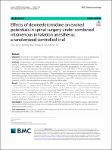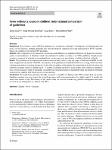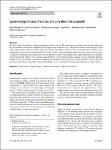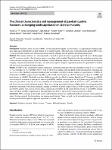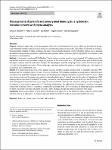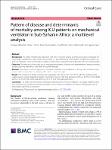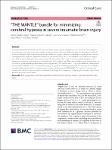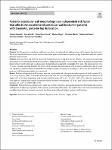Search
Author
- Daqing, Ma (3)
- Alexis, Ferré (2)
- Anna, Lybeck (2)
- Ashish K., Khanna (2)
- next >
Subject
- intensive care unit (8)
- acute respiratory dist... (5)
- chronic obstructive pu... (5)
- ICU (5)
- next >
Date issued
Has File(s)
Search Results
Hyponatremia is an independent predictor of poor prognosis, including increased mortality and readmission, in COPD patients. Identifying modifiable etiologies of hyponatremia may help reduce adverse events in patients with AECOPD. Therefore, the aim of this study was to explore the risk factors and underlying etiologies of hyponatremia in AECOPD patients. |
We aimed to investigate the effects of different doses of dexmedetomidine (Dex) on evoked potentials in adult patients undergoing spinal surgery under intravenous anesthesia with low-concentration desflurane. |
An increasing clinical workload and growing financial, administrative and legal burdens as well as changing demands regarding work-life balance have resulted in an increased emphasis on clinical practice at the expense of research activities by orthopaedic trauma surgeons. This has led to an overall decrease in the number of scientifically active clinicians in orthopaedic trauma surgery, which represents a serious burden on research in this field. In order to guarantee that the clinical relevance of this discipline is also mirrored in the scientific field, new concepts are needed to keep clinicians involved in research. |
Fever without a source (FWS) in children poses a diagnostic challenge. To distinguish a self-limiting infection from a serious infection, multiple guidelines have been developed to aid physicians in the management of FWS. Currently, there is no comparison of existing FWS guidelines. |
Because of their low incidence, studies about carpal fractures are rare. The aim of the present study was to analyze epidemiology and treatment of fractured carpal bones. We retrospectively analyzed data of 178 patients admitted to our emergency room with carpal fractures over 6 years. More males than woman were injured. In 91%, a CT scan was performed. The most commonly affected bone was the triquetrum followed by the scaphoid. Almost all triquetral fractures were treated conservatively as opposed to perilunate dislocations that were all operated on. Half of all patients with scaphoid fractures were operated. Young men had the highest risk to sustain a carpal fracture. |
Paediatric pelvic fractures (PPFs) are uncommon but signify serious trauma. A comprehensive multidisciplinary approach is needed due to a high number of associated injuries. This study aims to retrospectively analyse PPFs over a 5-year period and evaluate how advancing skeletal maturity changes fracture patterns and management plans. |
Numerous approaches to the management of juvenile and aneurysmal bone cysts (ABC) are described in the specialist literature together with discussion of the associated healing and recurrence rates. Since there is currently no evidence-based treatment standard for these conditions, the aim of this systematic literature review with meta-analysis was to examine the different management approaches, evaluate the corresponding clinical outcomes and, as appropriate, to formulate a valid treatment recommendation. |
The global mortality rate of patients with MV is very high, despite a significant variation worldwide. Previous studies conducted in Sub-Saharan Africa among ICU patients focused on the pattern of admission and the incidence of mortality. However, the body of evidence on the clinical outcomes among patients with MV is still uncertain. |
To ensure neuronal survival after severe traumatic brain injury, oxygen supply is essential. Cerebral tissue oxygenation represents the balance between oxygen supply and consumption, largely reflecting the adequacy of cerebral perfusion. Multiple physiological parameters determine the oxygen delivered to the brain, including blood pressure, hemoglobin level, systemic oxygenation, microcirculation and many factors are involved in the delivery of oxygen to its final recipient, through the respiratory chain. |
Smaller posterior acetabular walls have been shown to independently influence the risk for bipolar hip dislocation. We asked whether differences would also be observed in patients with traumatic posterior hip dislocation with and without posterior wall fractures. |


